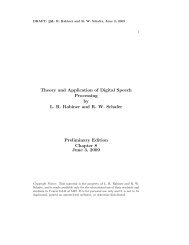Theory and Application of Digital Speech Processing by L. R. ...
Theory and Application of Digital Speech Processing by L. R. ...
Theory and Application of Digital Speech Processing by L. R. ...
Create successful ePaper yourself
Turn your PDF publications into a flip-book with our unique Google optimized e-Paper software.
DRAFT: L. R. Rabiner <strong>and</strong> R. W. Schafer, June 3, 2009<br />
26 CHAPTER 1. INTRODUCTION TO DIGITAL SPEECH PROCESSING<br />
Figure 1.14: General view <strong>of</strong> information manipulation <strong>and</strong> processing<br />
basic information source <strong>and</strong> the measurement or observation is generally the<br />
acoustic waveform (although it could equally well be a set <strong>of</strong> positions <strong>of</strong> the<br />
articulators (over time), or even measurements <strong>of</strong> the neural control signals for<br />
the articulators.<br />
Signal processing involves first obtaining a representation <strong>of</strong> the signal based<br />
on a given model <strong>and</strong> then applying <strong>of</strong> some higher level transformation in order<br />
to put the signal into a more convenient form. The last step in the process is the<br />
extraction <strong>and</strong> utilization <strong>of</strong> the message information <strong>by</strong> either human listeners<br />
or machines. By way <strong>of</strong> example, a system whose function is to automatically<br />
identify a speaker from a given set <strong>of</strong> speakers might use a time-dependent<br />
spectral representation <strong>of</strong> the speech signal. One possible signal transformation<br />
would be to average spectra across an entire sentence, compare the average<br />
spectrum to a stored averaged spectrum template for each possible speaker,<br />
<strong>and</strong> then based on a spectral similarity measurement choose the identity <strong>of</strong> the<br />
unknown speaker. For this example, the information in the signal is the identity<br />
<strong>of</strong> the speaker.<br />
Thus we see that processing <strong>of</strong> speech signals generally involves two tasks.<br />
First, it is a vehicle for obtaining a general representation <strong>of</strong> a speech signal<br />
in either waveform or parametric form. Second, signal processing serves the<br />
function <strong>of</strong> aiding in the process <strong>of</strong> transforming the signal representation into<br />
alternate forms which are less general in nature, but more appropriate to specific<br />
applications. Throughout this book we will see numerous specific examples <strong>of</strong><br />
the importance <strong>of</strong> signal processing in the area <strong>of</strong> speech communication.

















